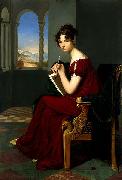Großhandels China Öl Gemälde & Rahmt Ein |
|||||||||||

|
|||||||||||
|
|
|
||||||||||||||
|
Carl Christian Vogel von Vogelstein
(26 June 1788, Wildenfels, Kursachsen - 4 March 1868, Munich), born Vogel, was a German painter. Son of the child and portrait painter Christian Leberecht Vogel, Vogel was trained early in life by his father. From 1804 he visited the Kunstakademie in Dresden, where he copied many paintings in the Gemäldegalerie and also produced the first of his own portraits. In 1807 he replied to an invitation from Baron von Löwenstern, whose children he had taught in Dresden, to come to Dorpat in Livland. In 1808 he moved to Saint Petersburg, where he set up a studio in the princely and successfully worked producing portraits of nobles and diplomats. In 1812 Vogel was finally rich enough to make a long-desired grand tour to Italy, stopping off at Berlin and Dresden on the way, where he painted his parents and Franz Pettrich. From 1813 to 1820 he lived in Rome, where many German artists were active at that time. He tried to run a middle course between the classicising and romanticising schools then prevailing there, with a style of his own closely drawing on that of Raphael Mengs. In Italy he copied a large number of paintings and wall paintings by the old masters. On later journeys he further augmented his collection of copies and in 1860 published a catalogue of them. Besides religious paintings, landscapes and anatomical studies, Vogel also produced portraits in Rome, of subjects such as Bertel Thorvaldsen, Lucien Bonaparte and - on behalf of the king of Saxony - Pope Pius VII. Vogel much enjoyed Rome, as Ringseis illustrates by this story - in 1818 he received a gift of a bottle of 1634 Rheinwein wine (given by crown prince Louis I of Bavaria in thanks for the decoration of a festal hall) by unanimous resolution of his colleagues |
||||||||||||||
|
|
||||||||||||||
|
||||||||||||||
|
|
||||||||||||||
| Carl Christian Vogel von Vogelstein
(26 June 1788, Wildenfels, Kursachsen - 4 March 1868, Munich), born Vogel, was a German painter. Son of the child and portrait painter Christian Leberecht Vogel, Vogel was trained early in life by his father. From 1804 he visited the Kunstakademie in Dresden, where he copied many paintings in the Gemäldegalerie and also produced the first of his own portraits. In 1807 he replied to an invitation from Baron von Löwenstern, whose children he had taught in Dresden, to come to Dorpat in Livland. In 1808 he moved to Saint Petersburg, where he set up a studio in the princely and successfully worked producing portraits of nobles and diplomats. In 1812 Vogel was finally rich enough to make a long-desired grand tour to Italy, stopping off at Berlin and Dresden on the way, where he painted his parents and Franz Pettrich. From 1813 to 1820 he lived in Rome, where many German artists were active at that time. He tried to run a middle course between the classicising and romanticising schools then prevailing there, with a style of his own closely drawing on that of Raphael Mengs. In Italy he copied a large number of paintings and wall paintings by the old masters. On later journeys he further augmented his collection of copies and in 1860 published a catalogue of them. Besides religious paintings, landscapes and anatomical studies, Vogel also produced portraits in Rome, of subjects such as Bertel Thorvaldsen, Lucien Bonaparte and - on behalf of the king of Saxony - Pope Pius VII. Vogel much enjoyed Rome, as Ringseis illustrates by this story - in 1818 he received a gift of a bottle of 1634 Rheinwein wine (given by crown prince Louis I of Bavaria in thanks for the decoration of a festal hall) by unanimous resolution of his colleagues artwork: 1816 cyf |
||||||||||||||
|
Related Paintings to Carl Christian Vogel von Vogelstein :. |
||||||||||||||
|
|
||||||||||||||
|
|
||||||||||||||
|
KONTAKTIEREN Sie UNS |







